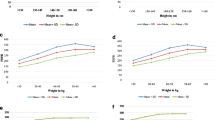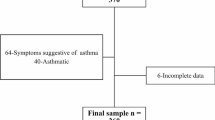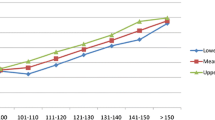Abstract
Background
Peak expiratory flow rate (PEFR) recording is an essential measure in the management and evaluation of asthmatic children. The PEFR can be measured by a simple instrument—peak expiratory flow meter. The aim of this study was to determine the normal PEFR in rural school children from Wardha district of Maharashtra state, India.
Methods
The PEFR was measured in 1078 healthy rural school children, living in Wardha district, Maharashtra using the Mini-Wright peak flow meter. All measurements were obtained in a standing position and the best out of three trials was recorded. Anthropometric measurements, weight, height, and mid-upper-arm circumference (MAC) were recorded, and body surface area (BSA) and body mass index (BMI) were calculated.
Results
Positive correlation was seen between age, height, weight and PEFR. The regression equations for PEFR were determined for boys and girls separately. The boys had higher values than the girls at all heights. The prediction equation for PEFR based on height was PEFR = 3.64 height (cm) − 257.86 (R=0.47, R 2=0.22) for female; PEFR = 4.7 height (cm) − 346.51 (R=0.62, R 2=0.38) for male.
Conclusion
PEFR is a reliable measurement, which can be used routinely and regularly in rural areas for assessment of airway obstruction and prediction formula derived for use in this population.
Similar content being viewed by others
References
Udupihille M. Peak expiratory flow rate in Sri Lankan schoolchildren of Sinhalese ethnic origin. Respir Med 1994;88:219–227.
Graff-Lonnevig V, Harfi H, Tipirneni P. Peak expiratory flow rates in healthy Saudi Arabian children living in Riyadh. Ann Allergy 1993;71:446–450.
Ismail Y, Azmi NN, Zurkurnain Y. Lung function in Malay children. Med J Malaysia 1993;48:171–174.
Malik SK, Jindal SK, Banga N, Sharda PK, Gupta HD. Peak expiratory flow rate of healthy north Indian teachers. Indian J Med Res 1980;71:322–324.
Kamat SR, Tyagi NK, Rashid SSA. Lung function in Indian adult subjects. Lung India 1982;1:11–21.
Malik SK, Jindal SK, Sharda PK, Banga N. Peak expiratory flow rates of healthy school girls from Punjab. Indian Pediatr 1982;18:161–164.
Swaminathan S, Venkatesan P, Mukunthan R. Peak expiratory flow rate in south Indian children. Indian Pediatr 1993;30:207–211.
Raju PS, Prasad KV, Ramana YV, Ahmed SK, Murthy KJ. Study on lung function tests and prediction equations in Indian male children. Indian Pediatr 2003;40:705–711.
Parmar VR, Kumar L, Malik SK. Normal values of peak expiratory flow rate in healthy North Indian school children, 6–16 years of age. Indian Pediatr 1977;14:591–594.
Singh HD, Peri S. Peak expiratory flow rates in South Indian children and adolescents. Indian Pediatr 1978;11:473–478.
Mahajan KK, Mahajan SK, Maini BK, Srivastava SC. Peak expiratory flow rate and its prediction formulae in Haryanavis. Indian J Physiol Pharmacol 1984;28:319–325.
Kashyap S, Puri DS, Bansal SK. Peak expiratory flow rates of healthy tribal children living at high altitudes in the Himalayas. Indian Pediatr 1992;29:283–286.
Sharma R, Jain A, Arya A, Chowdhary BR. Peak expiratory flow rate of school going rural children aged 5–14 years from Ajmer district. Indian Pediatr 2002;39:75–78.
Vijayan VK, Kuppurao KV, Venkatesan P, Sankaran K, Prabhakar R. Pulmonary function in healthy young adult Indians in Madras. Throax 1990;45:611–615.
Mohammadzadeh I, Gharagozlou M, Fatemi SA. Normal values of peak expiratory flow rate in children from the town of Babol, Iran. Iran J Allergy Asthma Immunol 2006;5:195–198.
Pulickal AS, Fernandez GV. Peak expiratory flow rate in healthy rural south Indian school children predicted from body height. Indian J Public Health 2007;51:117–119.
Paramesh H. Normal peak expiratory flow rate in urban and rural children. Indian J Pediatr 2003;70:375–377.
Swaminathan S, Diffey B, Vaz M. Evaluating the suitability of prediction equations for lung function in Indian children: a practical approach. Indian Pediatr 2006;43:680–698.
Prasad R, Verma SK, Agrawal GG, Mathur N. Prediction model for peak expiratory flow in North Indian population. Indian J Chest Dis Allied Sci 2006;48:103–106.
Nku CO, Peters EJ, Eshiet AI, Bisong SA, Osim EE. Prediction formulae for lung function parameters in females of south eastern Nigeria. Niger J Physiol Sci 2006;21:43–47.
Author information
Authors and Affiliations
Corresponding author
Rights and permissions
About this article
Cite this article
Taksande, A., Jain, M., Vilhekar, K. et al. Peak expiratory flow rate of rural school children from Wardha district, Maharashtra in India. World J Pediatr 4, 211–214 (2008). https://doi.org/10.1007/s12519-008-0039-1
Received:
Accepted:
Published:
Issue Date:
DOI: https://doi.org/10.1007/s12519-008-0039-1




